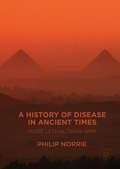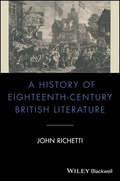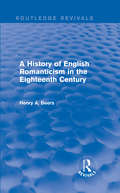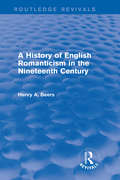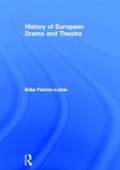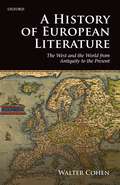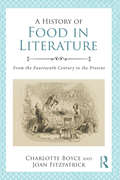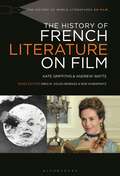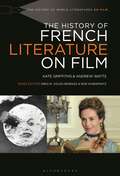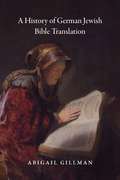- Table View
- List View
The History Of Danish Dreams
by Peter HøegPeter Høeg's first novel is an interweaving of the lives and loves of four families, within which histories time expands, clocks stop or race forward at will. The dreams and disappointments of the children of the author's magnificent imagination foreshadow the themes of Miss Smilla's Feeling for Snow and Borderliners
A History of Disease in Ancient Times: More Lethal than War
by Philip NorrieThis book shows how bubonic plague and smallpox helped end the Hittite Empire, the Bronze Age in the Near East and later the Carthaginian Empire. The book will examine all the possible infectious diseases present in ancient times and show that life was a daily struggle for survival either avoiding or fighting against these infectious disease epidemics. The book will argue that infectious disease epidemics are a critical link in the chain of causation for the demise of most civilizations in the ancient world and that ancient historians should no longer ignore them, as is currently the case.
A History of Eighteenth-Century British Literature (Blackwell History of Literature)
by John RichettiA History of Eighteenth-Century British Literature is a lively exploration of one of the most diverse and innovative periods in literary history. Capturing the richness and excitement of the era, this book provides extensive coverage of major authors, poets, dramatists, and journalists of the period, such as Dryden, Pope and Swift, while also exploring the works of important writers who have received less attention by modern scholars, such as Matthew Prior and Charles Churchill. Uniquely, the book also discusses noncanonical, working-class writers and demotic works of the era. During the eighteenth-century, Britain experienced vast social, political, economic, and existential changes, greatly influencing the literary world. The major forms of verse, poetry, fiction and non-fiction, experimental works, drama, and political prose from writers such as Montagu, Finch, Johnson, Goldsmith and Cowper, are discussed here in relation to their historical context. A History of Eighteenth-Century British Literature is essential reading for advanced undergraduates and graduate students of English literature. Topics covered include: Verse in the early 18th century, from Pope, Gay, and Swift to Addison, Defoe, Montagu, and Finch Poetry from the mid- to late-century, highlighting the works of Johnson, Gray, Collins, Smart, Goldsmith, and Cowper among others, as well as women and working-class poets Prose Fiction in the early and 18th century, including Behn, Haywood, Defoe, Swift, Richardson, Fielding, and Smollett The novel past mid-century, including experimental works by Johnson, Sterne, Mackenzie, Walpole, Goldsmith, and Burney Non-fiction prose, including political and polemical prose 18th century drama
A History of Eighteenth-Century British Literature (Blackwell History of Literature)
by John RichettiA History of Eighteenth-Century British Literature is a lively exploration of one of the most diverse and innovative periods in literary history. Capturing the richness and excitement of the era, this book provides extensive coverage of major authors, poets, dramatists, and journalists of the period, such as Dryden, Pope and Swift, while also exploring the works of important writers who have received less attention by modern scholars, such as Matthew Prior and Charles Churchill. Uniquely, the book also discusses noncanonical, working-class writers and demotic works of the era. During the eighteenth-century, Britain experienced vast social, political, economic, and existential changes, greatly influencing the literary world. The major forms of verse, poetry, fiction and non-fiction, experimental works, drama, and political prose from writers such as Montagu, Finch, Johnson, Goldsmith and Cowper, are discussed here in relation to their historical context. A History of Eighteenth-Century British Literature is essential reading for advanced undergraduates and graduate students of English literature. Topics covered include: Verse in the early 18th century, from Pope, Gay, and Swift to Addison, Defoe, Montagu, and Finch Poetry from the mid- to late-century, highlighting the works of Johnson, Gray, Collins, Smart, Goldsmith, and Cowper among others, as well as women and working-class poets Prose Fiction in the early and 18th century, including Behn, Haywood, Defoe, Swift, Richardson, Fielding, and Smollett The novel past mid-century, including experimental works by Johnson, Sterne, Mackenzie, Walpole, Goldsmith, and Burney Non-fiction prose, including political and polemical prose 18th century drama
A History of English Literature (Macmillan Foundations Series)
by Michael AlexanderThis comprehensive text traces the development of one of the world’s richest literatures from the Old English period through to the present day, discussing a wide range of key authors without losing its clarity or verve. Building on the book's established reputation and success, the third edition has been revised and updated throughout. It now provides a full final chapter on the contemporary scene, with more on genres and the impact of globalization.This accessible book remains the essential companion for students of English literature and literary history, or for anyone wishing to follow the unfolding of writing in England from its beginnings. It is ideal for those who know a few landmark texts, but little of the literary landscape that surrounds them; those who want to know what English literature consists of; and those who simply want to read its fascinating story.
A History of English Literature (Macmillan Foundations Series)
by Michael AlexanderThis comprehensive text traces the development of one of the world's richest literatures from the Old English period through to the present day, discussing a wide range of key authors without losing its clarity or verve. Building on the book's established reputation and success, the third edition has been revised and updated throughout. It now provides a full final chapter on the contemporary scene, with more on genres and the impact of globalization.This accessible book remains the essential companion for students of English literature and literary history, or for anyone wishing to follow the unfolding of writing in England from its beginnings. It is ideal for those who know a few landmark texts, but little of the literary landscape that surrounds them; those who want to know what English literature consists of; and those who simply want to read its fascinating story.New to this Edition:- Fully revised throughout- A full final chapter on contemporary writing, with closer attention paid to the growing diversity of literatures in English in the British Isles
A History of English Romanticism in the Eighteenth Century (Routledge Revivals)
by Henry A. BeersFirst published in 1926, this title presents the great artistic and literary innovations of the Romantic movement according to an often overlooked and unacknowledged definition of ‘Romanticism’, which is of particular relevance in the consideration of the English Romantic spirit: pertaining to the style of the Christian and popular literature of the Middle Ages.
A History of English Romanticism in the Eighteenth Century (Routledge Revivals)
by Henry A. BeersFirst published in 1926, this title presents the great artistic and literary innovations of the Romantic movement according to an often overlooked and unacknowledged definition of ‘Romanticism’, which is of particular relevance in the consideration of the English Romantic spirit: pertaining to the style of the Christian and popular literature of the Middle Ages.
A History of English Romanticism in the Nineteenth Century (Routledge Revivals)
by Henry A. BeersA History of English Romanticism in the Nineteenth Century, first published in 1926, presents the great artistic and literary innovations of the Romantic movement according to an often overlooked and unacknowledged definition of ‘Romanticism’, which is of particular relevance in the consideration of the English Romantic spirit: pertaining to the style of the Christian and popular literature of the Middle Ages. The author recapitulates the key contributions of English poets – including Scott, Coleridge and Keats - in light of their recovery of certain themes and leitmotifs that clearly distinguish the Romantic style. In addition, the development of the Romantic movement in France and Germany is given some attention, and the specific tendencies of their respective approaches is considered in relation to England. The emergence of the Pre-Raphaelites is investigated, and a tentative evaluation of the progress of English Romanticism in the nineteenth century is offered.
A History of English Romanticism in the Nineteenth Century (Routledge Revivals)
by Henry A. BeersA History of English Romanticism in the Nineteenth Century, first published in 1926, presents the great artistic and literary innovations of the Romantic movement according to an often overlooked and unacknowledged definition of ‘Romanticism’, which is of particular relevance in the consideration of the English Romantic spirit: pertaining to the style of the Christian and popular literature of the Middle Ages. The author recapitulates the key contributions of English poets – including Scott, Coleridge and Keats - in light of their recovery of certain themes and leitmotifs that clearly distinguish the Romantic style. In addition, the development of the Romantic movement in France and Germany is given some attention, and the specific tendencies of their respective approaches is considered in relation to England. The emergence of the Pre-Raphaelites is investigated, and a tentative evaluation of the progress of English Romanticism in the nineteenth century is offered.
History of European Drama and Theatre (PDF)
by Erika Fischer-LichteThis major study reconstructs the vast history of European drama from Greek tragedy through to twentieth-century theatre, focusing on the subject of identity. Throughout history, drama has performed and represented political, religious, national, ethnic, class-related, gendered, and individual concepts of identity. Erika Fischer-Lichte's topics include: ancient Greek theatre, Shakespeare and Elizabethan theatre, the German Enlightenment, Romanticism and the twentieth century. Anyone interested in theatre throughout history and today will find this an invaluable source of information.
A History of European Literature: The West and the World from Antiquity to the Present
by Walter CohenWalter Cohen argues that the history of European literature and each of its standard periods can be illuminated by comparative consideration of the different literary languages within Europe and by the ties of European literature to world literature. World literature is marked by recurrent, systematic features, outcomes of the way that language and literature are at once the products of major change and its agents. Cohen tracks these features from ancient times to the present, distinguishing five main overlapping stages. Within that framework, he shows that European literatures ongoing internal and external relationships are most visible at the level of form rather than of thematic statement or mimetic representation. European literature emerges from world literature before the birth of Europe — during antiquity, whose Classical languages are the heirs to the complex heritage of Afro-Eurasia. This legacy is later transmitted by Latin to the various vernaculars. The uniqueness of the process lies in the gradual displacement of the learned language by the vernacular, long dominated by Romance literatures. That development subsequently informs the second crucial differentiating dimension of European literature: the multicontinental expansion of its languages and characteristic genres, especially the novel, beginning in the Renaissance. This expansion ultimately results in the reintegration of European literature into world literature and thus in the creation of todays global literary system. The distinctiveness of European literature is to be found in these interrelated trajectories.
A History of Falling Things (Modern Plays)
by James Graham'Oh, you do look...really good, though. You know. In the face. Oh and, uh, I love you.'Prisoners of their fear of falling things - keraunothetophobiacs - Jacqui and Robin are restricted to living indoors. When they meet online a relationship begins which forces them to confront their fear and discover what's real in their lives and what really matters.A History of Falling Things, a new play by the acclaimed young playwright James Graham, is a gentle love story that is fearful, funny and moving. The play premiered at Clwyd Theatr Cymru, Wales, in April 2009 before transferring to the Sherman Theatre, Cardiff.
A History of Falling Things: A History Of Falling Things, Tory Boyz, The Man, The Whisky Taster, Sons Of York (Modern Plays)
by James Graham'Oh, you do look...really good, though. You know. In the face. Oh and, uh, I love you.'Prisoners of their fear of falling things - keraunothetophobiacs - Jacqui and Robin are restricted to living indoors. When they meet online a relationship begins which forces them to confront their fear and discover what's real in their lives and what really matters.A History of Falling Things, a new play by the acclaimed young playwright James Graham, is a gentle love story that is fearful, funny and moving. The play premiered at Clwyd Theatr Cymru, Wales, in April 2009 before transferring to the Sherman Theatre, Cardiff.
The History of Fatherhood in Norway, 1850–2012 (Global Masculinities)
by J. LorentzenThe first study of its kind, this book traces 150 years of the history of fatherhood in Scandinavia and shows how Scandinavian gender equality policy has important implications for the rest of the world. Among other interesting findings, Lorentzen reveals that the modern-day rise in equality fathering can be traced back to the 19th century.
A History of Food in Literature: From the Fourteenth Century to the Present
by Charlotte Boyce Joan FitzpatrickWhen novels, plays and poems refer to food, they are often doing much more than we might think. Recent critical thinking suggests that depictions of food in literary works can help to explain the complex relationship between the body, subjectivity and social structures. A History of Food in Literature provides a clear and comprehensive overview of significant episodes of food and its consumption in major canonical literary works from the medieval period to the twenty-first century. This volume contextualises these works with reference to pertinent historical and cultural materials such as cookery books, diaries and guides to good health, in order to engage with the critical debate on food and literature and how ideas of food have developed over the centuries. Organised chronologically and examining certain key writers from every period, including Chaucer, Shakespeare, Austen and Dickens, this book's enlightening critical analysis makes it relevant for anyone interested in the study of food and literature.
A History of Food in Literature: From the Fourteenth Century to the Present
by Charlotte Boyce Joan FitzpatrickWhen novels, plays and poems refer to food, they are often doing much more than we might think. Recent critical thinking suggests that depictions of food in literary works can help to explain the complex relationship between the body, subjectivity and social structures. A History of Food in Literature provides a clear and comprehensive overview of significant episodes of food and its consumption in major canonical literary works from the medieval period to the twenty-first century. This volume contextualises these works with reference to pertinent historical and cultural materials such as cookery books, diaries and guides to good health, in order to engage with the critical debate on food and literature and how ideas of food have developed over the centuries. Organised chronologically and examining certain key writers from every period, including Chaucer, Shakespeare, Austen and Dickens, this book's enlightening critical analysis makes it relevant for anyone interested in the study of food and literature.
A History of French Literature: From Chanson de geste to Cinema
by David CowardThis magnificent volume provides a complete history of the literature of France from its origins to the present day, taking us beyond traditional definitions of ‘literature' into the world of the best-seller and, beyond words, to graphic fiction and cinema Presents a definitive history of the literature of France from its origins to the present day. Incorporates coverage of Francophone writing in Europe, Canada, the West Indies and North and Sub-Saharan Africa. Links the development of literature to the mentalities and social conditions which produced it. Takes us beyond “literature” to study graphic fiction, cinema and the bestseller. Maps the rise of the Intellectual, and in so doing charts a progression from literary doctrine to critical theory.
The History of French Literature on Film (The History of World Literatures on Film)
by Andrew Watts Kate GriffithsFrench novels, plays, poems and short stories, however temporally or culturally distant from us, continue to be incarnated and reincarnated on cinema screens across the world. From the silent films of Georges Méliès to the Hollywood production of Gustave Flaubert's Madame Bovary directed by Sophie Barthes, The History of French Literature on Film explores the key films, directors, and movements that have shaped the adaptation of works by French authors since the end of the 19th century. Across six chapters, Griffiths and Watts examine the factors that have driven this vibrant adaptive industry, as filmmakers have turned to literature in search of commercial profits, cultural legitimacy, and stories rich in dramatic potential. The volume also explains how the work of theorists from a variety of disciplines (literary theory, translation theory, adaptation theory), can help to deepen both our understanding and our appreciation of literary adaptation as a creative practice. Finally, this volume seeks to make clear that adaptation is never a simple transcription of an earlier literary work. It is always simultaneously an adaptation of the society and era for which it is created. Adaptations of French literature are thus not only valuable artistic artefacts in their own right, so too are they important historical documents which testify to the values and tastes of their own time.
The History of French Literature on Film (The History of World Literatures on Film)
by Andrew Watts Kate GriffithsFrench novels, plays, poems and short stories, however temporally or culturally distant from us, continue to be incarnated and reincarnated on cinema screens across the world. From the silent films of Georges Méliès to the Hollywood production of Gustave Flaubert's Madame Bovary directed by Sophie Barthes, The History of French Literature on Film explores the key films, directors, and movements that have shaped the adaptation of works by French authors since the end of the 19th century. Across six chapters, Griffiths and Watts examine the factors that have driven this vibrant adaptive industry, as filmmakers have turned to literature in search of commercial profits, cultural legitimacy, and stories rich in dramatic potential. The volume also explains how the work of theorists from a variety of disciplines (literary theory, translation theory, adaptation theory), can help to deepen both our understanding and our appreciation of literary adaptation as a creative practice. Finally, this volume seeks to make clear that adaptation is never a simple transcription of an earlier literary work. It is always simultaneously an adaptation of the society and era for which it is created. Adaptations of French literature are thus not only valuable artistic artefacts in their own right, so too are they important historical documents which testify to the values and tastes of their own time.
A History of German Jewish Bible Translation
by Abigail GillmanBetween 1780 and 1937, Jews in Germany produced numerous new translations of the Hebrew Bible into German. Intended for Jews who were trilingual, reading Yiddish, Hebrew, and German, they were meant less for religious use than to promote educational and cultural goals. Not only did translations give Jews vernacular access to their scripture without Christian intervention, but they also helped showcase the Hebrew Bible as a work of literature and the foundational text of modern Jewish identity. This book is the first in English to offer a close analysis of German Jewish translations as part of a larger cultural project. Looking at four distinct waves of translations, Abigail Gillman juxtaposes translations within each that sought to achieve similar goals through differing means. As she details the history of successive translations, we gain new insight into the opportunities and problems the Bible posed for different generations and gain a new perspective on modern German Jewish history.
A History of German Jewish Bible Translation
by Abigail GillmanBetween 1780 and 1937, Jews in Germany produced numerous new translations of the Hebrew Bible into German. Intended for Jews who were trilingual, reading Yiddish, Hebrew, and German, they were meant less for religious use than to promote educational and cultural goals. Not only did translations give Jews vernacular access to their scripture without Christian intervention, but they also helped showcase the Hebrew Bible as a work of literature and the foundational text of modern Jewish identity. This book is the first in English to offer a close analysis of German Jewish translations as part of a larger cultural project. Looking at four distinct waves of translations, Abigail Gillman juxtaposes translations within each that sought to achieve similar goals through differing means. As she details the history of successive translations, we gain new insight into the opportunities and problems the Bible posed for different generations and gain a new perspective on modern German Jewish history.
A History of German Jewish Bible Translation
by Abigail GillmanBetween 1780 and 1937, Jews in Germany produced numerous new translations of the Hebrew Bible into German. Intended for Jews who were trilingual, reading Yiddish, Hebrew, and German, they were meant less for religious use than to promote educational and cultural goals. Not only did translations give Jews vernacular access to their scripture without Christian intervention, but they also helped showcase the Hebrew Bible as a work of literature and the foundational text of modern Jewish identity. This book is the first in English to offer a close analysis of German Jewish translations as part of a larger cultural project. Looking at four distinct waves of translations, Abigail Gillman juxtaposes translations within each that sought to achieve similar goals through differing means. As she details the history of successive translations, we gain new insight into the opportunities and problems the Bible posed for different generations and gain a new perspective on modern German Jewish history.
A History of German Jewish Bible Translation
by Abigail GillmanBetween 1780 and 1937, Jews in Germany produced numerous new translations of the Hebrew Bible into German. Intended for Jews who were trilingual, reading Yiddish, Hebrew, and German, they were meant less for religious use than to promote educational and cultural goals. Not only did translations give Jews vernacular access to their scripture without Christian intervention, but they also helped showcase the Hebrew Bible as a work of literature and the foundational text of modern Jewish identity. This book is the first in English to offer a close analysis of German Jewish translations as part of a larger cultural project. Looking at four distinct waves of translations, Abigail Gillman juxtaposes translations within each that sought to achieve similar goals through differing means. As she details the history of successive translations, we gain new insight into the opportunities and problems the Bible posed for different generations and gain a new perspective on modern German Jewish history.
A History of German Jewish Bible Translation
by Abigail GillmanBetween 1780 and 1937, Jews in Germany produced numerous new translations of the Hebrew Bible into German. Intended for Jews who were trilingual, reading Yiddish, Hebrew, and German, they were meant less for religious use than to promote educational and cultural goals. Not only did translations give Jews vernacular access to their scripture without Christian intervention, but they also helped showcase the Hebrew Bible as a work of literature and the foundational text of modern Jewish identity. This book is the first in English to offer a close analysis of German Jewish translations as part of a larger cultural project. Looking at four distinct waves of translations, Abigail Gillman juxtaposes translations within each that sought to achieve similar goals through differing means. As she details the history of successive translations, we gain new insight into the opportunities and problems the Bible posed for different generations and gain a new perspective on modern German Jewish history.

